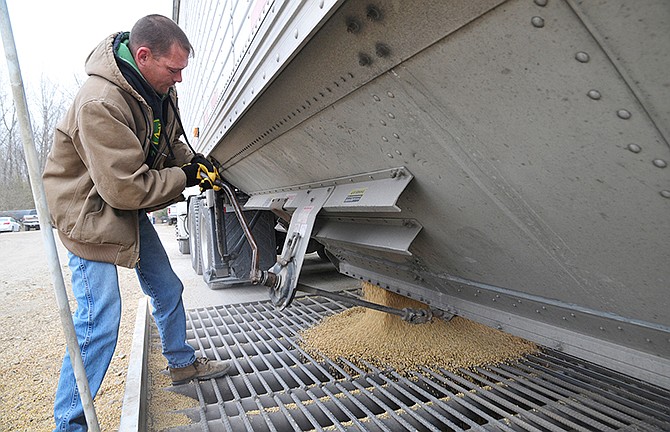An unusually large fall harvest has filled regional grain elevators to capacity, leaving farmers fewer options for selling and storing their crops this year.
The largest Missouri fall corn harvest on record was in 2004 when farmers grew almost 467 million bushels; this year's production is forecasted at 603 million bushels. This year's soybean crop is also up by 50 million bushels over 2013.
"It's a huge harvest," reported Loren Luebbert, general manager at MFA in Jefferson City. "All of the elevators are full, or almost full, to capacity."
He noted both hill and riverbottom farmers are experiencing "astronomical" yields this year for both crops.
For the first time in 10 years, Jefferson City MFA AgriServices is offloading soybeans directly from farmers' trucks onto waiting barges on the Missouri River this week in an effort to move the grain to market. The barges are loaded with a conveyor belt owned by Capital Sand Company and bound for the Gulf of Mexico.
MFA filled four barges in Jefferson City a few weeks ago, and filled an additional three barges last week.
Each container is able to ship between 50,000 to 55,000 bushels of soybeans - which means approximately 350,000 bushels of soybeans will be transported by barge instead of by highway.
"It's a huge benefit to farmers and to MFA," Luebbert said.
Moving the grain down the Missouri River frees up storage space in other regional MFA elevators, which are also facing similar storage issues.
"MFA (company-wide) has gotten 20 barges through the course of the fall," Luebbert noted.
Luebbert noted his own facility has narrowly avoided being closed to farmers, although it is filled almost to capacity.
"We've never been completely "plugged up,' but we did ask a few drivers on Saturday (Nov. 8) to wait until the next day," he added.
A significant portion of this year's corn crop has been stockpiled outdoors on the ground near the Jefferson City MFA. Some 165,000 bushels of grain is protected with tarpaulins both above and below the piles, and most is able to be air-dried. Such storage is typical even for non-record-breaking years, he said.
Eventually most of it will be ground into livestock feed in MFA's own mills or it will be taken to the Cargill plant in California, Missouri.
In addition to MFA and Cargill, Central Missouri farmers have two other main outlets to deliver their product: the Archer Daniels Midland plant in Mexico and the ethanol refinery plants in Laddonia and Malta Bend.
This fall, those groups also are limited in their capacity to accept farmers' loads.
The POET ethanol biorefinery in Laddonia is essentially full. Managers there have reduced its hours of operation and would prefer to wait until December to buy more corn. Cargill is buying corn and operating within normal hours, but is purchasing the fall crop at 35 cents below the Chicago Board of Trade's price.
Also ADM - which processes soybeans into a variety of products, including animal feed and biodiesel - has curtailed its drop-off hours.
Part of the difficulty this fall is that elevator managers in places like Centralia can't secure the rail cars they need. Unlike the Jefferson City MFA elevator - which has no rail access - Centralia's MFA is situated at the nexus of two railroads.
"But it's been a challenge to get rail cars," lamented Jim Gestling, of Centralia's MFA.
The last time he faced such a big crop, more than 160 rail cars moved the grain out. This time, he's struggling to secure 20.
"They (rail cars) are practically nonexistent," he said.
Norfolk Southern Railway finally agreed to assign Gestling - who will share the rail cars with another MFA elevator - 19 cars they can use to shuttle grain to St. Louis.
The difficulty lies, in part, with an increase in oil and gas rail shipments at the expense of ag commodities.
"In 2009, there were 11,000 rail carloads of crude oil; but in 2013, there were 400,000 carloads," said Mike Steenhoek, executive director of the Soybean Transportation Coalition in Iowa. "It's like having a fire hydrant hooked up to a garden hose."
Extremely cold temperatures in 2013 also complicated the situation for shippers, Steenhoek noted. To ensure air brakes still worked, rail companies like BNSF had to run shorter trains - 4,500 feet long instead of the usual 7,000-foot length.
The coalition reported Friday that grain shippers are experiencing "substantial frustration" with rail service this year, according to survey results.
"One of the primary reasons why U.S. agriculture has been so competitive is due to our more-developed transportation system, which includes our freight network," said Pat Knouff, coalition chairman. "The decline in rail service has understandably raised concern among agricultural shippers and farmers."
At the moment, barge service on the Missouri River is helping balance shortcomings in rail transportation. The U.S. Army Corps of Engineers is maintaining above normal releases at the four lower dams, according to MarineLink.com. The excess water will allow the Corps to extend the navigation season and provide navigation service until Dec. 10.
Gestling thought his elevator's size might explain why rail cars have been difficult to secure.
He noted the rail companies would rather deal with corporations capable of booking 50 to 100 cars at a time.
Like Luebbert, Gestling is moving most of the crop out by truck. But that's coming at an extra expense as well. He noted drivers who formerly were willing to back-haul grain to St. Louis for 25 cents per bushel are now demanding 72 cents.
"But I flat-out refuse to do a ground pile," he said. "To me, quality is more important than volume."
Dan Engemann, with the Missouri Soybean Merchandising Council, said flaws in the nation's transportation system are being highlighted with this fall's unusually large harvest.
"But it's a good problem to have," Engemann. "We always prefer a bumper crop."

